A Novel Microtiter Plate Format High Power Open Source LED Array
Abstract
1. Introduction
2. Materials and Methods
2.1. Setup 1
2.2. Setup 2
2.3. Setup 3
2.4. LED Emision Intesity Measurement
3. Results and Discussion
3.1. LED Mounting and Cooling
3.2. Light Intensity and Heat Management
4. Conclusions
Supplementary Materials
Author Contributions
Funding
Acknowledgments
Conflicts of Interest
References
- Quoc, T.; Peter, K.; Quang, B.; Vinh, T.; Winkler, H. LED Lighting: Technology and Perception; Wiley VCH Verlag GmbH & Co. KGaA: Weinheim, Germany, 2014. [Google Scholar] [CrossRef]
- Narendran, N.; Deng, L.; Pysar, R.M.; Gu, Y.; Yu, H. Performance characteristics of high-power light-emitting diodes. Anal. Biochem. 2004, 5187, 267–275. [Google Scholar] [CrossRef]
- Nakamura, S. Nobel lecture: Background story of the invention of efficient blue ingan light emitting diodes. Nobel Lect. 2015, 87, 1139–1151. [Google Scholar] [CrossRef]
- Morita, D.; Sano, M.; Yamamoto, M.; Murayama, T.; Nagahama, S.-I.; Mukai, T. High output power 365 nm ultraviolet light emitting diode of gan-free structure. Jpn. J. Appl. Phys. 2002, 41, 1434. [Google Scholar] [CrossRef]
- Khan, A.; Balakrishnan, K.; Katona, T. Ultraviolet light-emitting diodes based on group three nitrides. Nat. Photonics 2008, 2, 77. [Google Scholar] [CrossRef]
- Yole Developement. UV LEDs—Technology, Manufacturing and Application Trends 2018; Technical Report; Yole Developpement: Milpitas, CA, USA, 2018. [Google Scholar]
- Hoelz, K.; Lietard, J.; Somoza, M.M. High-power 365 nm UV LED mercury arc lamp replacement for photochemistry and chemical photolithography. ACS Sustain. Chem. Eng. 2017, 5, 828–834. [Google Scholar] [CrossRef] [PubMed]
- Matafonova, G.; Batoev, V. Recent advances in application of UV light-emitting diodes for degrading organic pollutants in water through advanced oxidation processes: A review. Water Res. 2018, 132, 177–189. [Google Scholar] [CrossRef] [PubMed]
- Smith, K.C. Dose dependent decrease in extractability of DNA from bacteria following irradiation with ultraviolet light or with visible light plus dye. Biochem. Biophys. Res. Commun. 1962, 8, 157–163. [Google Scholar] [CrossRef]
- Singh-Gasson, S.; Green, R.D.; Yue, Y.; Nelson, C.; Blattner, F.; Sussman, M.R.; Cerrina, F. Maskless fabrication of light-directed oligonucleotide microarrays using a digital micromirror array. Nat. Biotechnol. 1999, 17, 974–978. [Google Scholar] [CrossRef] [PubMed]
- Hansen, L.B.; Buus, S.; Schafer-Nielsen, C. Identification and mapping of linear antibody epitopes in human serum albumin using high-density peptide arrays. PLoS ONE 2013, 8, 1–10. [Google Scholar] [CrossRef] [PubMed]
- Forsström, B.; Axnäs, B.B.; Stengele, K.P.; Bühler, J.; Albert, T.J.; Richmond, T.A.; Hu, F.J.; Nilsson, P.; Hudson, E.P.; Rockberg, J.; et al. Proteome-wide epitope mapping of antibodies using ultra-dense peptide arrays. Mol. Cell. Proteom. 2014, 13, 1585–1597. [Google Scholar] [CrossRef] [PubMed]
- Takeda, K.; Fujisawa, K.; Nojima, H.; Kato, R.; Ueki, R.; Sakugawa, H. Hydroxyl radical generation with a high power ultraviolet light emitting diode (UV-LED) and application for determination of hydroxyl radical reaction rate constants. J. Photochem. Photobiol. A Chem. 2017, 340, 8–14. [Google Scholar] [CrossRef]
- Khademalrasool, M.; Farbod, M.; Talebzadeh, M.D. The improvement of photocatalytic processes: Design of a photoreactor using high-power LEDs. J. Sci. Adv. Mater. Devices 2016, 1, 382–387. [Google Scholar] [CrossRef]
- Bochet, C.G. Photolabile protecting groups and linkers. J. Chem. Soc. Perkin Trans. 2002, 1, 125–142. [Google Scholar] [CrossRef]
- Jasenak, B.S. How to Design with LEDs: Concurrent Engineering Yields Fully Optimized Lighting Systems; LED Professional: Dornbirn, Austria, 2016. [Google Scholar]
- Barbosa, J.L.F.; Simon, D.; Calixto, W.P. Design Optimization of a High-power LED Matrix Luminaire. Energies 2017, 10, 639. [Google Scholar] [CrossRef]
- CELED 96 Hardware Manual. Available online: https://www.cetoni.de/fileadmin/user_upload/Documents/Manuals/Manual_Hardware_ceLED96_EN.pdf. (accessed on 20 February 2019).
- Bullough, J. LED Lighting Systems; Technical Report; Lightning Research Center: Troy, NY, USA, 2003. [Google Scholar]
- Klàn, P.; Åolomek, T.; Bochet, C.G.; Blanc, A.; Givens, R.; Rubina, M.; Popik, V.; Kostikov, A.; Wirz, J. Photoremovable protecting groups in chemistry and biology: Reaction mechanisms and efficacy. Chem. Rev. 2013, 113, 119–191. [Google Scholar] [CrossRef] [PubMed]
- Naqvi, A.; Nahar, P. Photochemical immobilization of proteins on microwave-Synthesized photoreactive polymers. Anal. Biochem. 2004, 327, 68–73. [Google Scholar] [CrossRef] [PubMed]
- Haddon, M.; Smith, T. The chemistry and applications of UV-cured adhesives. Int. J. Adhes. Adhes. 1991, 11, 183–186. [Google Scholar] [CrossRef]
- Available online: https://www.brand.de/products/life-science-products/brandplatesr-microplates/technical-data-sheets/ (accessed on 20 February 2019).
- Available online: https://www.theseus.fi/bitstream/handle/10024/80460/Schutt_Ekaterina.pdf?sequence=1&isAllowed=y (accessed on 20 February 2019).
- Available online: https://www.cypress.com/file/38656/download (accessed on 20 February 2019).
- Priante, D.; Elafandy, R.T.; Prabaswara, A.; Janjua, B.; Zhao, C.; Alias, M.S.; Tangi, M.; Alaskar, Y.; Albadri, A.M.; Alyamani, A.Y.; et al. Diode junction temperature in ultraviolet algan quantum-disks-in-nanowires. J. Appl. Phys. 2018, 124, 015702. [Google Scholar] [CrossRef]
- Perera, I.; Liu, Y.-W.; Narendran, N. Accurate measurement of LED lens surface temperature. Proc. SPIE Int. Soc. Opt. Eng. 2013, 8835. [Google Scholar] [CrossRef]
- Available online: https://www.cree.com/led-components/media/documents/XLampThermalManagement.pdf (accessed on 20 February 2019).
- Available online: https://www.axionbiosystems.com/products/lumos (accessed on 20 February 2019).
- Available online: https://www.prizmatix.com/UHP/UHP-LED-for-96-Wells-Microplate-Illumination.htm (accessed on 20 February 2019).
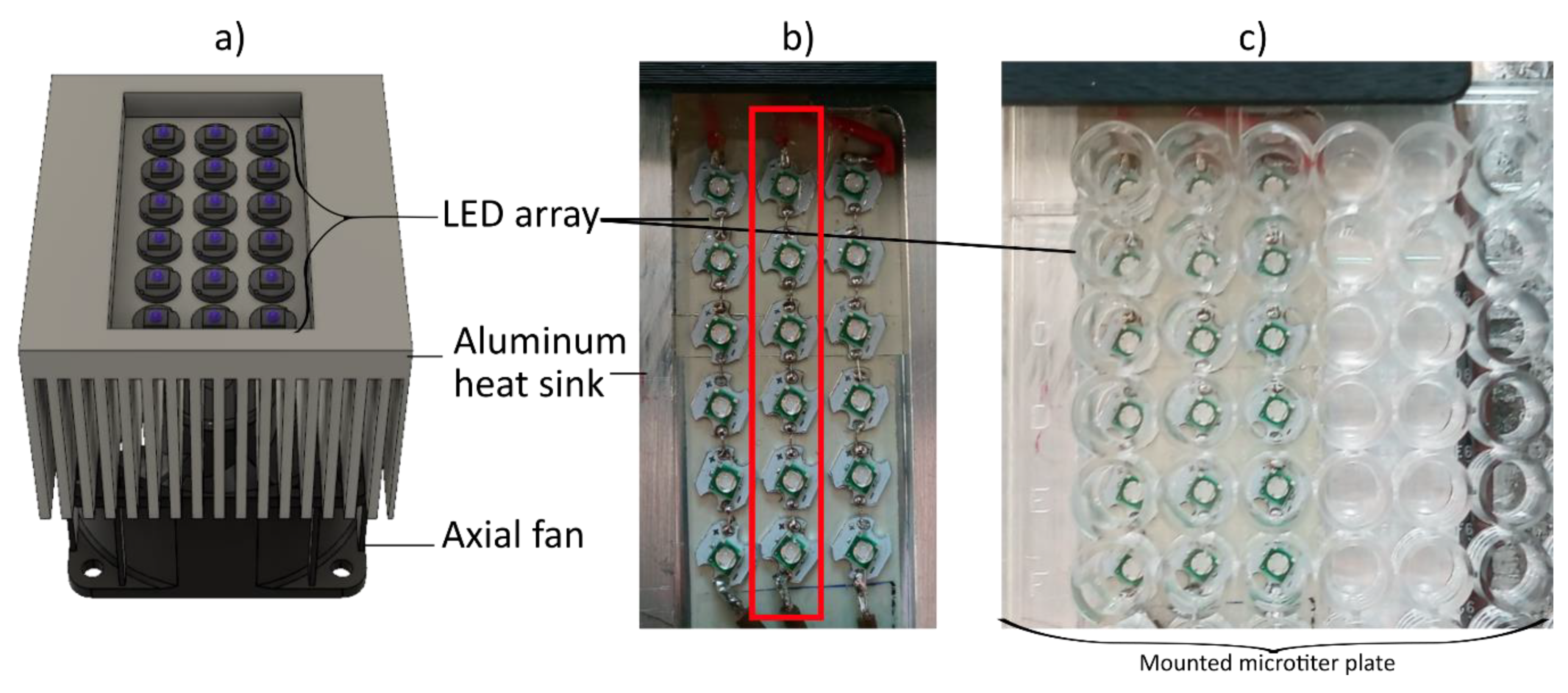
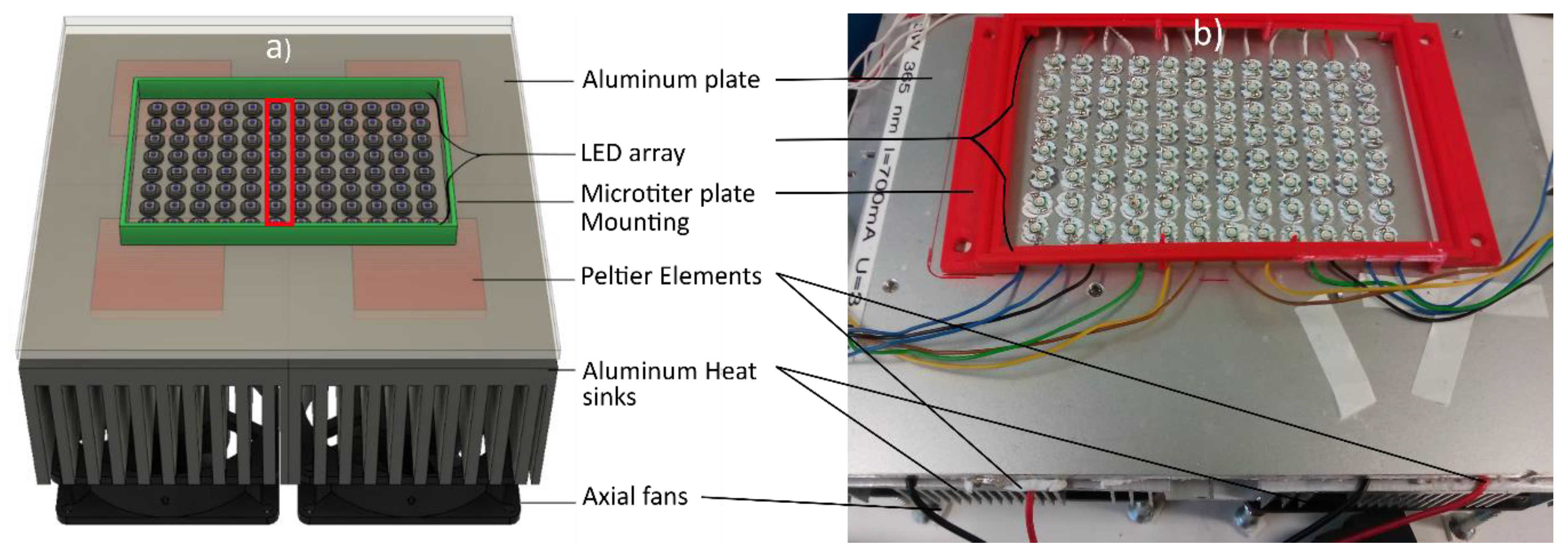
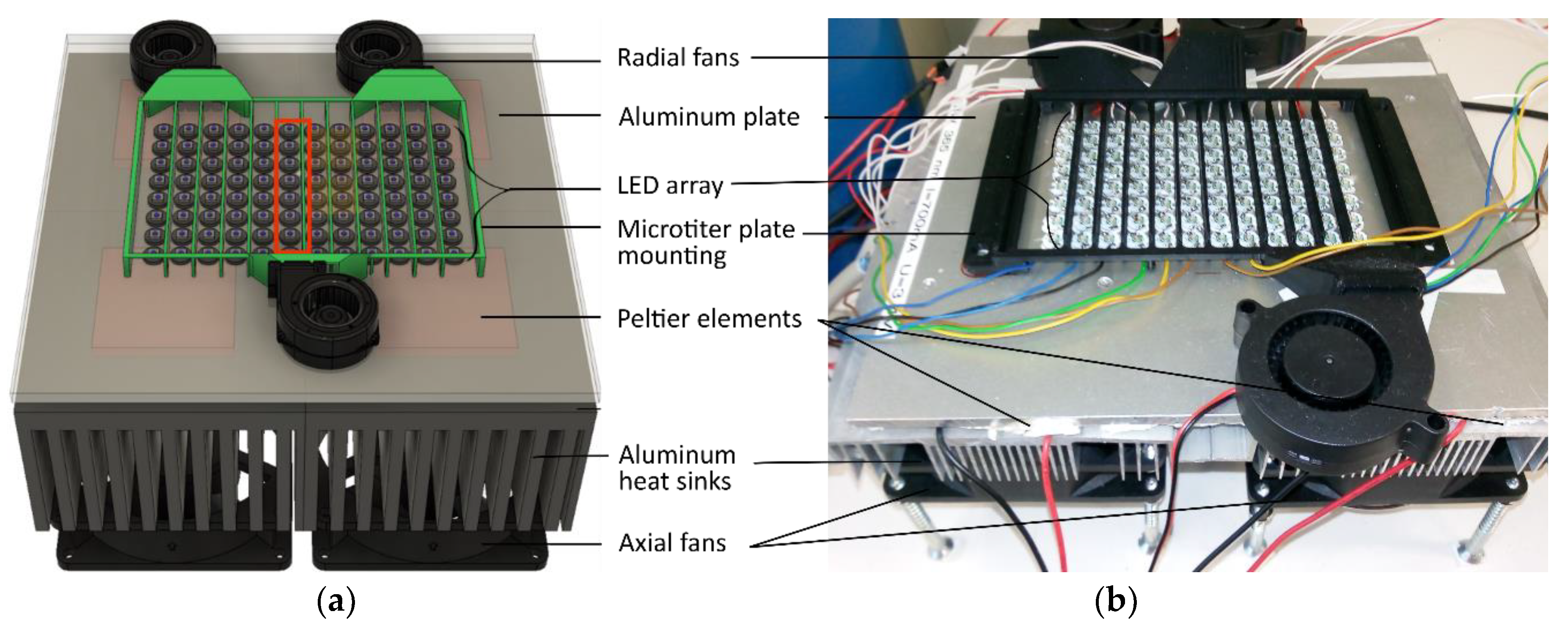
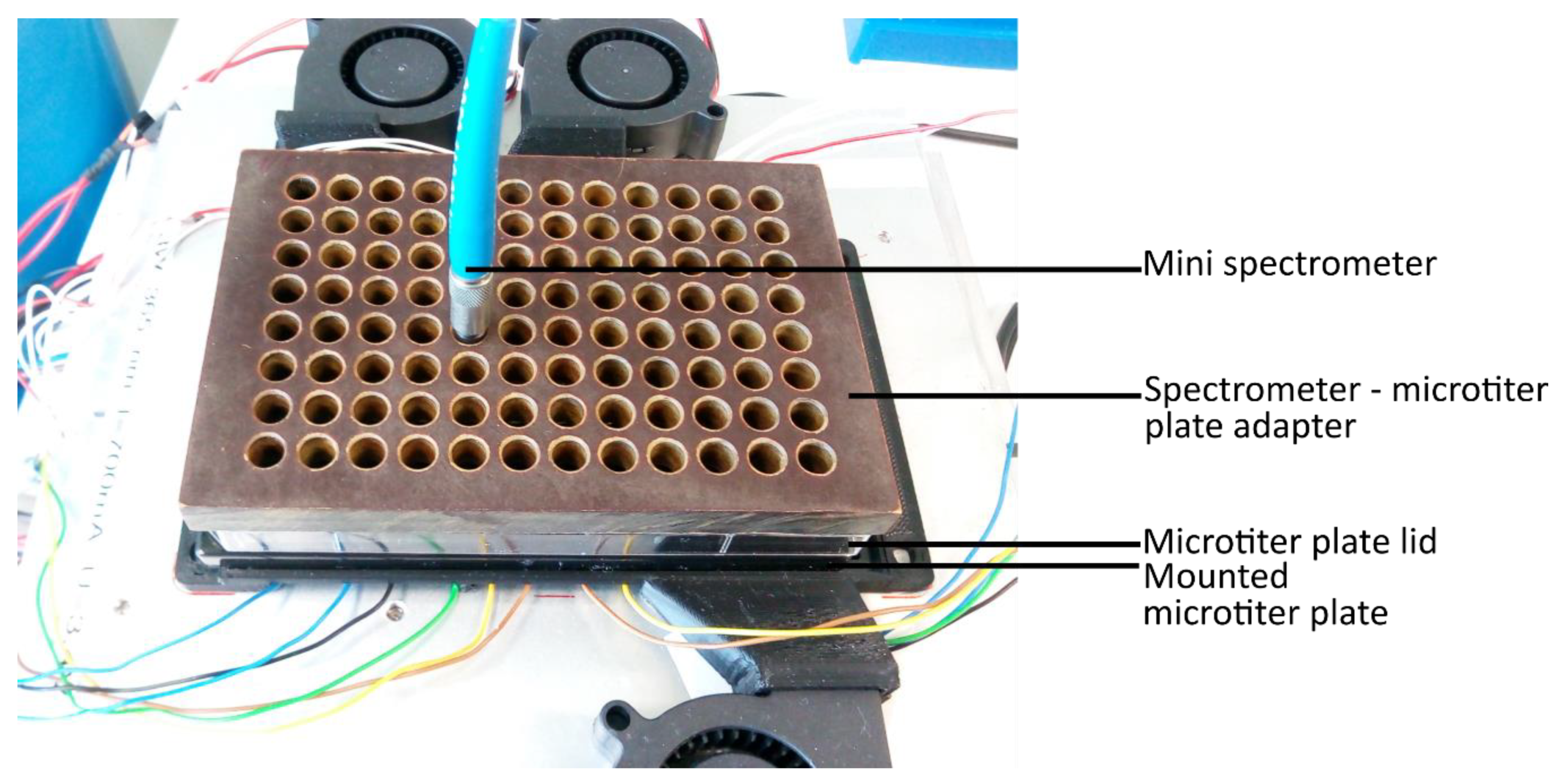
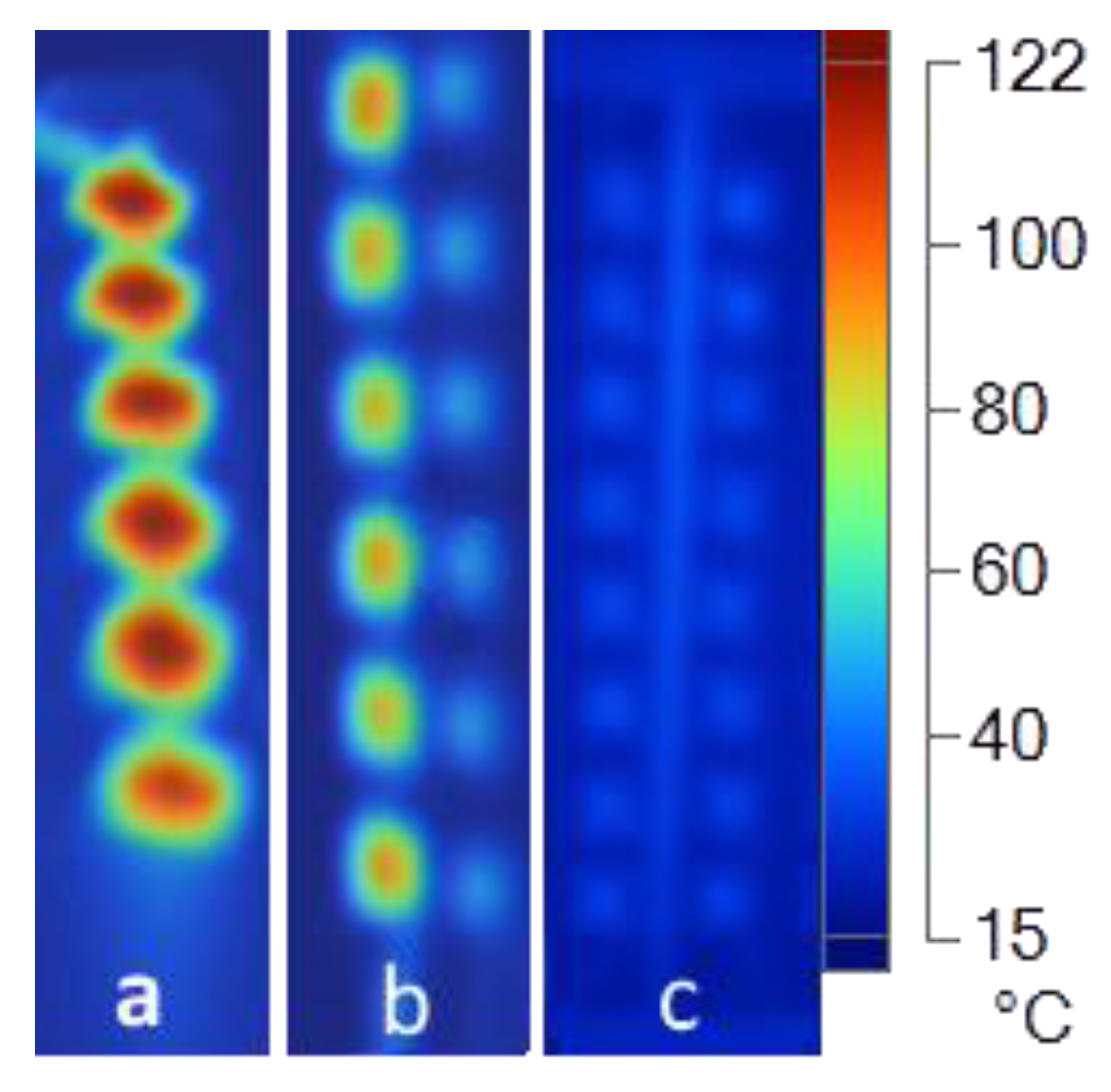
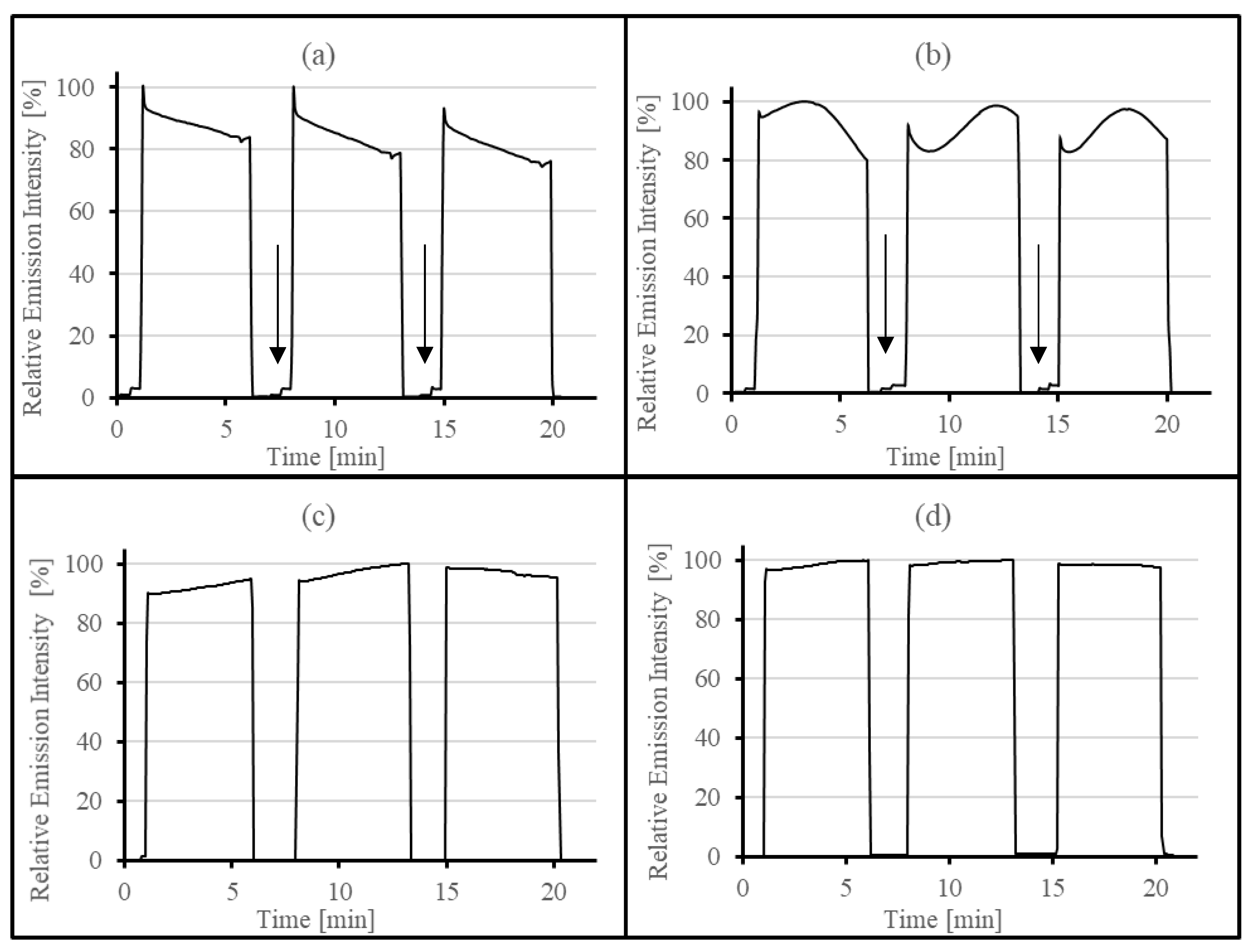
| Device | Technical Data | Setup 1 | Setup 2 | Setup 3 |
|---|---|---|---|---|
| LED driver | 700 LDD L 700 mA, 9–36 V | 3× | 12× | 12× |
| Aluminum heat sink | SK92-100-SA 100 × 100 × 40 mm 1 K/W | 1× | 4× | 4× |
| Aluminum plate | 20 × 20 × 0.05 cm | |||
| 365 nm HP LED | smd3535 Forward voltage (UF)UF = 3.5 V Forward current (IF)IF = 700 mA | 18× | 96× | 96× |
| Microcontroller | Arduino Uno | 1× | 1× | 1× |
| Axial fan | 12 V, DC 500 mA | 1× | 4× | 4× |
| Radial fan | 12 V, DC 500 mA | - | - | 3× |
| Peltier element | TEC1-12706, 60 W | - | 4× | - |
| Peltier element | TEC1-12710, 80 W | - | - | 4× |
| Absolute maximum emission intensity | In fluorescence units | 34,008 | 44,638 | 50,079 |
| Circa setup cost | In Euro | 57 | 250 | 262 |
© 2019 by the authors. Licensee MDPI, Basel, Switzerland. This article is an open access article distributed under the terms and conditions of the Creative Commons Attribution (CC BY) license (http://creativecommons.org/licenses/by/4.0/).
Share and Cite
Kagel, H.; Jacobs, H.; Bier, F.F.; Glökler, J.; Frohme, M. A Novel Microtiter Plate Format High Power Open Source LED Array. Photonics 2019, 6, 17. https://doi.org/10.3390/photonics6010017
Kagel H, Jacobs H, Bier FF, Glökler J, Frohme M. A Novel Microtiter Plate Format High Power Open Source LED Array. Photonics. 2019; 6(1):17. https://doi.org/10.3390/photonics6010017
Chicago/Turabian StyleKagel, Heike, Hannes Jacobs, Frank F. Bier, Jörn Glökler, and Marcus Frohme. 2019. "A Novel Microtiter Plate Format High Power Open Source LED Array" Photonics 6, no. 1: 17. https://doi.org/10.3390/photonics6010017
APA StyleKagel, H., Jacobs, H., Bier, F. F., Glökler, J., & Frohme, M. (2019). A Novel Microtiter Plate Format High Power Open Source LED Array. Photonics, 6(1), 17. https://doi.org/10.3390/photonics6010017





